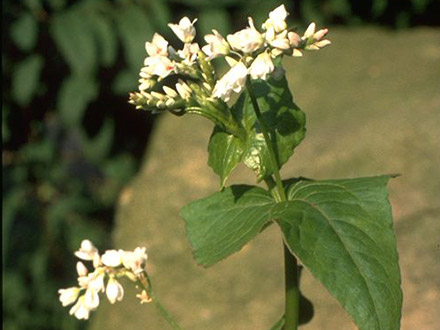Botanical name
Fagopyrum esculentum Moench
Family
Polygonaceae
Common name
Common buckwheat, Japanese buckwheat
Information about the plant
Buckwheat arrived in Central Europe from its native Central Asia with the Mongols in the 14th century. It was known as ‘heather grain’ because it thrives on poor, sandy soils and was, therefore, previously favored in the heathlands of north-west Germany, initially in the Lüneburg Heath and later in the heathlands of Mecklenburg. Its occurrence is first documented in a Lüneburg certificate from 1385 under the name ‘bokwete’. After a strong decline in cultivation, it is now being cultivated again, as it has become an integral part of organic food. It can also be found growing wild on waste ground and field edges.
The German name ‘Buchweizen’ is mistakenly associated with a ‘grain’. However, it is an annual, up to 60 cm tall, fast-growing herb with alternate, very characteristic, heart-arrow-shaped leaves, the stipules of which grow together to form a collar-shaped ‘ochrea’ that envelops the growing point on the stem. The numerous white- to pink-colored, small flowers are grouped in compact, spike-like thyrses. They are very rich in nectar, which is why buckwheat is an important plant for feeding bees. It flowers from July to October. The fruits are reddish-brown, 4 to 6 mm long, and sharply triangular. This makes them reminiscent of beechnuts, the fruits of the beech tree. This is expressed in the genus name Fagopyrum, derived from the Latin ‘fagus’ (= beech) and the Greek ‘pyros’ (= wheat), literally translated into German as ‘buckwheat’. The species epithet esculentum means ‘edible’ (Latin ‘esca’ = food). The fruits are processed into groats, semolina, or flour.
Medicinally used parts of plants (herbal drug)
The dried herb, consisting of leaves, flowers, and stems (buckwheat herb - Fagopyri herba), harvested during the early flowering period before fruiting, is used.
The commercially available drug comes from Hungary and Africa.
Constituents of the herbal drug
Buckwheat herb contains rutoside and other flavonoids, as well as chlorogenic acid and phenolcarboxylic acids. The flowers contain fagopyrin, a photosensitizing naphthodianthrone, which is only detectable in small amounts in the drug.
Quality of the drug
The quality of buckwheat herb (Fagopyri herba) is specified in the European Pharmacopoeia (Ph. Eur.).
Medical applications
Recognised medical use
Buckwheat herb has not been evaluated by the HMPC or the ESCOP.
Indications supported by clinical data (authorization): for chronic venous insufficiency (CVI) stages I and II, as well as for microcirculatory disorders and for the prevention of arteriosclerosis.
Traditional use
Traditionally used alone or in combination with other preparations to improve the condition of tired legs (traditional use according to Article 16a of Directive 2001/83/EC).
Herbal drug preparations in finished dosage forms
Cut buckwheat herb for the preparation of a tea infusion or powdered buckwheat herb in tablets.
Dosage
Finished medicinal product: see patient information leaflet.
Tea: drink 1 cup of buckwheat tea 3 times a day for several weeks.
Preparation of a tea
Pour 150 mL of boiling water over 2 g of buckwheat herb and strain after 10 minutes. It is recommended to boil for 2 to 3 minutes.
Notes
No safety studies are available on the use of buckwheat herb during pregnancy and lactation. The clinical symptoms of chronic venous insufficiency (CVI) are not relevant in children and adolescents.
Side effects
Very rarely, headache.
Interactions
Not known.


